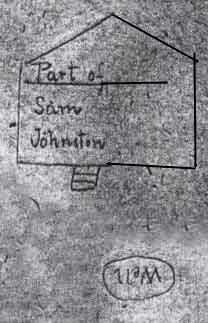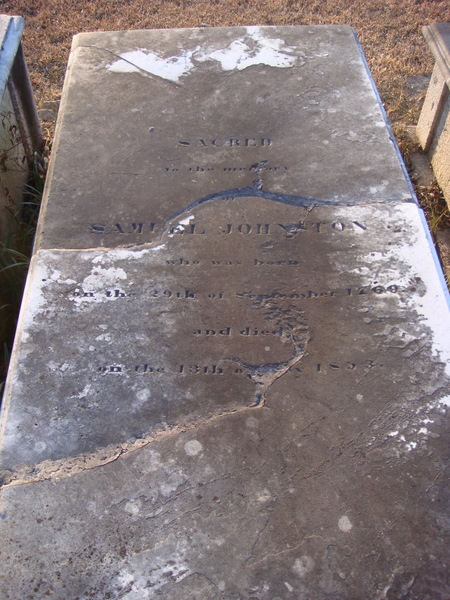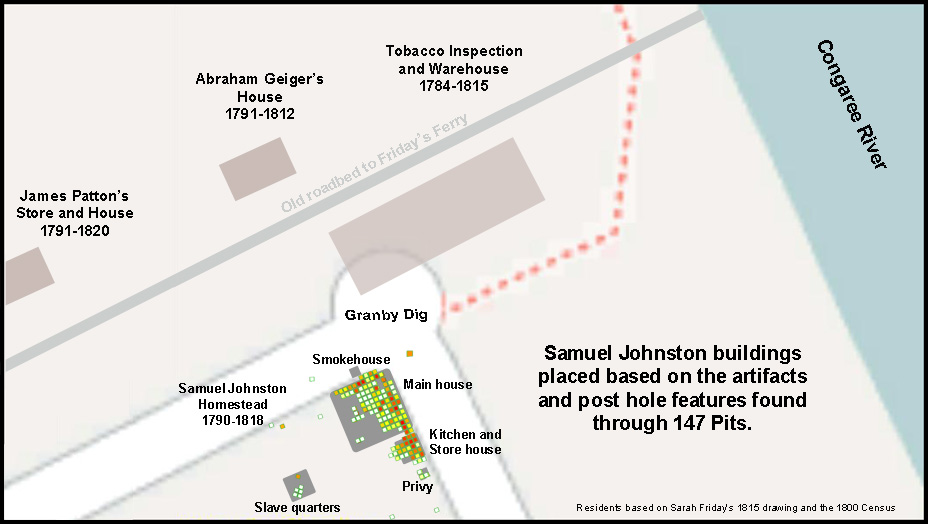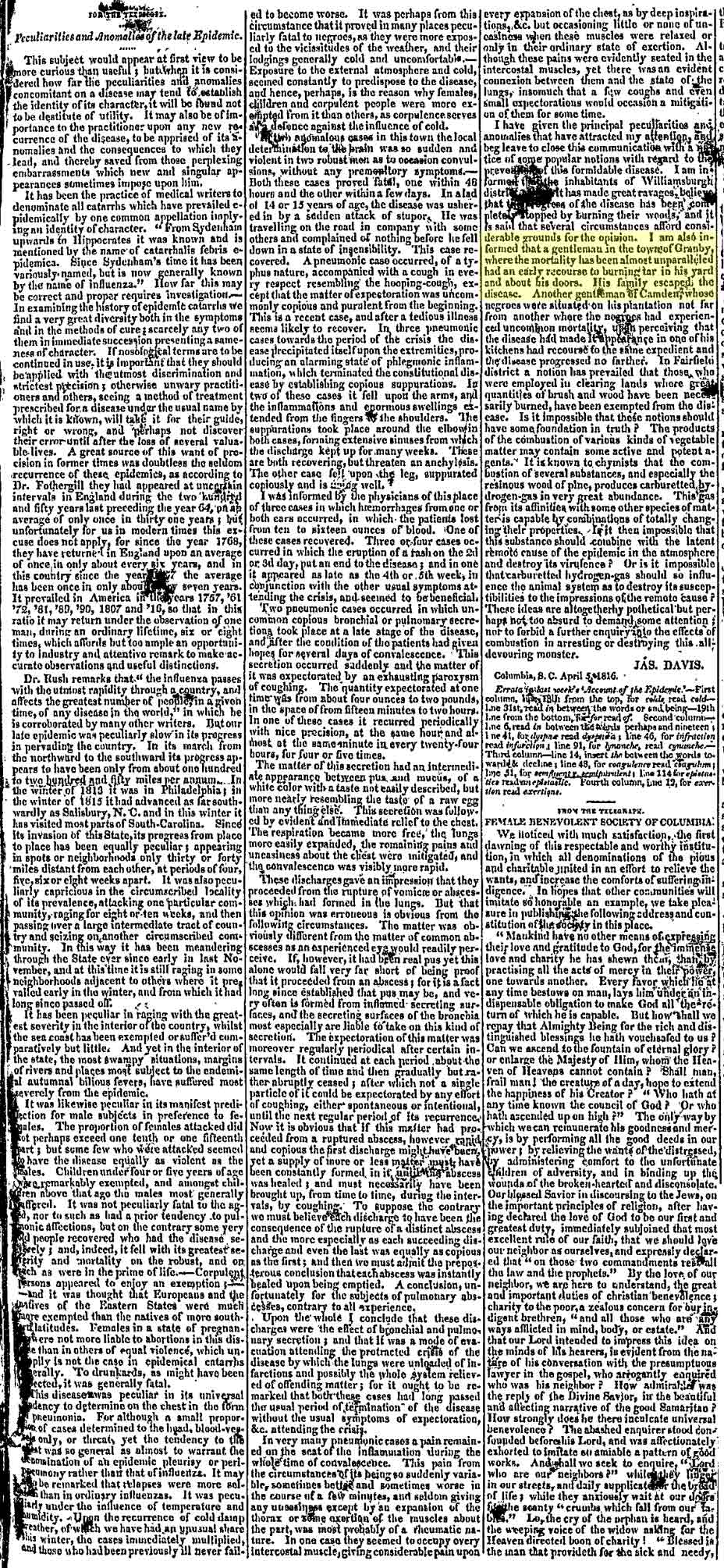Sarah Friday's 1810 Granby Drawing
Part of Sam Johnston

Samuel Johnston, was the son of David Johnston (b. l727) and Sarah Meek. He was born 29 September 1769 in the County of Londonderry, Ireland. With his mother and several brothers, he immigrated to South Carolina, arriving in Charleston 4 September 1787. He settled in Fairfield County where he became a planter. At one time Johnston's property included two tracts totaling 708 acres near Winnsboro, two houses and four lots in Winnsboro, another 100 acres in Fairfield District, seven lots and 368 acres in or near the town of Chester, and one house and lot in the village of Granby.
The 1800 Census shows Samuel living in Granby next to his brother Henry Johnston. At that time, in Granby, it appears that Samuel had a son between 10 and 15 and another son younger than 10. Another male in the house was between 26 and 44. This could not have been a son of Samuel since Samuel was only 31 years old in 1800. This may have been a brother. Also in 1800, in Granby, Samuel had 3 daughters between 10 and 15 and his wife was also between 26 and 44. He owned 10 slaves. Records on Findagrave, show that Samuel's first wife (Catherine Harrison Johnston) and daughter Carolina both died on August 28, 1799 in childbirth or maybe from Yellow Fever. The graves are "unknown" and could possibly be in the area of the Granby dig. The findagrave records show Samuel and Catherine had one other child born in 1796 (Sarah Dargan "Sally" Johnston Randell) but the 1800 census does not show her in Samuel's Granby home. Maybe she is the child under 10 shown in Henry's household. In addition to the 8 family members in Samuel's Granby home, there were also 10 slaves listed in the census. There were 8 people in Henry Johnston's 1800 Granby household but no slaves.
Below is Samuel Johnston's grave at the Sion Presbyterian Cemetery in Winnsboro, SC.

Public service for Johnston began with his election to the House. Fairfield chose him for the Eighteenth General Assembly (1808-1809), but the house declared him ineligible as he allegedly did not meet citizenship and residency requirements. However, he was reelected and qualified 28 November 1809. Subsequently, he represented Fairfield in the Nineteenth General Assembly (1810- 1812). While in the House, he was a m,ember of the committees on schools (1810-1812); and pensions (1810-1812). Johnston was elected to the State Senate by Fairfield and served in the Twentieth l (1812-1813), Twenty-first (1811- 1815), twenty-fourth (1820- 1891), and twenty-fifth (1822-1823) General Assemblies.
Johnston married three times. His first wife was Catherine Harrison, daughter of Burr Harrison and Eliza Dargan. Six children were born to them: David (b.1791), Burr, Eliza Meek, Sarah Dargan,(m. Theodore Randall), Harriett (m. Birt Harrington), and Carolina (B.&D. 1799. Catherine Harrison Johnston died 28 August, 1799. He then wed Rebecca Surginer who bore him eight children before she died 16 July 1823: John Surginer, Charlotte A. (m. John David Means), Caroline (m. Sylvanus Chambers), Juliet C. (m. John Caldwell Johnston), Samuel E., J. Madison, William David, and Rebecca Surginer (m. Harry Walker Adams 1815-1870). Elizabeth Crawford, daughter of Andrew Crawford and Jane Bones, was his third wife. They were the parents of five children: Andrew, Jane S. (m. Rufus Kirkpatrick Porter), Margaret Crawford (m. James Pickett Adams), Robert Crawford, and David (b.1835). Survived by his wife and at least fourteen children, Samuel Johnson died 13 May, 1853 in Winnsboro.
Burr Johnston (the Granby Gamecock) was born in Granby in 1791. He attended Newberry Academy in 1807 and 1808 and started college in 1809 at the new South Carolina College (USC). He and Granby friend William Arthur became the first Granbyans to graduate from South Carolina College in 1811. No doubt, Burr knew Sarah Friday and may have observed her, as she included the Samuel Johnston house in her drawing of Granby. After Burr’s graduation from South Carolina College, he studied medicine in Newberry for two years. He then opened a practice in Newberry. In 1840, he moved to Macon, Alabama, and continued to practice medicine there until his death in 1855. Burr’s son, John Foote Johnston (born in 1821), would also become a medical doctor.
Research is still being done on the Sam Johnston house and property. We believe that this may be the property of our Granby dig so it is important to complete a thorough archival search. Below is a graphic showing the artifact data that gives us an idea of the buildings that were on the Johnston property.

Early in the Granby dig, David Brinkman came across the following listing of South Carolina epidemics:
1787 Scarlatina Anginosa
1788 Scarlatina Anginosa
1790 Influenza
1792 Yellow Fever
1794 Yellow Fever
1795 Yellow Fever
1796 Yellow Fever
1797 Yellow Fever
1799 Yellow Fever
1800 Yellow Fever
1807 Influenza
1809 Yellow Fever, Whooping Cough
1814 Diphtheria
1815 Influenza
1816 Influenza, Smallpox
1817 Yellow Fever
1819 Yellow Fever
Granby was hit very hard by these epidemics during this period of time when Columbia was developing on the higher and healthier side of the river. Unknown to the people of the time was that mosquitoes were spreading many of these illnesses. The people, however, figured out that Granby was not a safe place and by the time Sarah Friday made her drawing of Granby (between 1810 and 1815), over half the population of Granby had moved to other locations. Brinkman also found the following newspaper article about the influenza epidemic of 1816. The article mentions a Granby man who successfully protected his family by burning tar around his property. Throughout the Granby dig we find asphalt in the top levels when digging (probably from the 1960 road) but there is also a strange black substance that we find deeper and have not identified it yet. We also find asphalt at the Fort Congaree II dig site but not this other material. Could the man mentioned in this 1816 article be the Sam Johnston that is shown in Sarah's drawing? Could this strange material be old tar?

Samuel Johnston home site: Status: The Finding Granby dig has completed about 75% of the possible archaeology that can be done on the site (Click here to see this location on a map)
Click here to view the Granby Archaeology results (mostly cetered at the Samuel Johnston home site.)